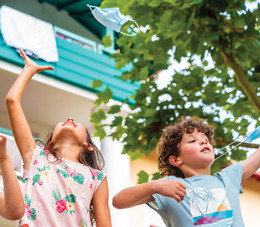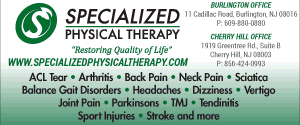
It’s been a painfully long two years.
Even that realization could be perceived as a gross understatement when you consider all that has transpired since the words COVID and coronavirus became synonymous with our daily existence. What started out as a 15-day plan to “slow the spread” has morphed into now more than 750 days since the first COVID-19 case in New Jersey was detected on March 2, 2020.
All along the way, we’ve been plagued by the uncertainty brought on by a new disease, which, at times, has led to new orders, changing guidance and varying opinions that caused plenty of confusion and ultimately distrust for those who took umbrage to the constant moving targets and polarizing mitigation efforts.
While vaccines, mask wearing and social distancing became fodder for politicos and pundits alike, the truth of the matter is that after two years of having this pandemic linger like an uninvited guest at a private party, COVID fatigue has set in with nearly everyone you talk to.
Now, with the number of coronavirus cases and hospitalizations on a sharp decline ever since the omicron variant caused a sizable spike toward the end of 2021, things are starting to feel more normalized across the country and here in South Jersey. But what exactly does normal look like now, and is everyone ready for COVID to fade from our consciousness?
Sarah Diorio, Psy.D, is a lecturer of psychology at Rowan University who says as time passes, it will be easier for folks to let go of their inhibitions, but undoubtedly there will be many who will need to see further progression before they feel comfortable living a little more carefree.
“COVID abruptly disrupted our daily routine and people adapted to the changes that were made. But for those who were negatively impacted by these changes—those dealing with social isolation for instance—they are eager to get out there and not be so anxious,” she says. “But other people will be more socially introverted and not adapting as well to the changes that are happening [as of late].
“It’s been two years of establishing new habits and new routines and it could be hard for them to break the habit of mask wearing and social distancing. I do think as time passes, it will lessen, but part of the population will continue to practice those safety measures.”
Jen Orengo is a Marlton resident who works as a critical care registered nurse in the ICU at Virtua Memorial Hospital. Having experienced the worst of COVID-19 up-close-and-personal, including having to FaceTime family members so they could say their last goodbyes to a dying loved one, she is cautiously letting her guard down.
“Just recently, I stopped wearing my mask into stores and honestly, it has given me a little bit of anxiety,” she says. “I am fully vaccinated, but the fear is always in the back of my head. I’m hopeful that it will fade in time.”
Orengo’s reservations aside, she is eager to be around her extended family once again. “We usually host Easter and the summer holidays at our house. However, we haven’t had my grandparents and aunts and uncles over because of the risk of exposure to COVID. My kids haven’t seen my husband’s parents and family for the last two years in person.”
Kevin Collins, of Washington Township, says he’s not sure that the world will ever get back to “normal,” especially as it pertains to his two young boys. “I think the world has changed in a fundamental way. Living through this pandemic has caused my youngest son to miss out on key development; he is more likely to want to stay at home now and play online. His social development has been stunted due to the pandemic,” he says.
When cases were spiking, Neill Carroll was avoiding any activities that involved being indoors with other people or in large crowds, but now that the most recent wave seems to be behind us, the Haddonfield resident is slowly returning to familiar territory.
“Just this past week, I went to the movies for the first time in two years. And my wife and I are planning a trip to Florida soon. I may change course again if a new, more dangerous variant appears, but I am cautiously—and perhaps illogically—optimistic that won’t happen again,” says Carroll.
While some are easing their way back into pre-pandemic pleasures, many others are chomping at the bit to reconnect with life as they once knew it. Whether it be dining at restaurants indoors again, sitting in the stands at a sporting event, attending a concert or getting on airplane, the pent-up demand for getting out and about has reached a crescendo.
Drew Polin and his wife Lynn are parents to two young daughters, ages 7 and 2. Up until recently, the Marlton family had done very little outside the comforts of home with the exception of dining outdoors. Despite concerns that their youngest is still not eligible to be vaccinated, the Polins are looking forward to taking their first family vacation since the pandemic began and will be heading to Disney World later this year.
“We were predominately doing all the protective stuff pretty religiously because of our parents and our kids,” Polin says. “But we made a decision a week ago that we’re done, we are going back to normal.”
Former Philadelphia Eagles beat reporter and Haddon Township resident Les Bowen and his wife started venturing out more after getting fully vaccinated and boosted last year, visiting restaurants and mingling in the crowd at concerts. As a result of getting the jab and having also contracted COVID, Bowen admits he’s not too apprehensive about gatherings these days and can’t wait to make up for lost time.
“I’m most looking forward to being able to plan a real vacation to a locale that might require a passport, something we haven’t even considered for two years,” he says.
Closer to home, towns all across South Jersey have banded together during these trying times, showing their resiliency and resolve. And now with more events and community celebrations filling up the calendar, there’s a renewed energy in the air, according to Moorestown Mayor Nicole Gillespie.
“There’s definitely excitement to be doing in-person events again. A lot of nonprofits were scraping by because they couldn’t do their fundraisers, and so people are happy to be able to help again at these events. And we haven’t had our July 4th parade since 2019, so it feels like our town is getting back to those things that make it so special and reversing that domino effect that was so damaging these last couple of years,” she says.
Evesham Mayor Jackie Veasy feels similarly, saying “one of the things I’m most excited for is having even more chances to meet with residents at our township events. I love every chance I can get to speak with our residents and just hear what’s on their minds. … That face-to-face interaction is so important.”
Veasy adds most of her constituents are comfortable where their community is a whole. “Our residents can look at [Evesham’s] high vaccination rates and low case counts and know they’re safe.”
As folks pine for the old days, one bright spot that has taken place during the pandemic has been the time it has afforded people to slow down, enjoy the small things a bit more and make noticeable lifestyle changes.
For Medford’s Carole Morganti, some of the changes she’s made these past two years are likely to stick with her long-term, even as the pandemic subsides.
“I have learned how important it is to take the time to do the things you always wanted to do. [During the pandemic] I started bird watching, kayaking and hiking, and I plan on continuing those activities. I joined a CSA [community-supported agriculture] and purchased a share of locally grown, organic farm produce to help me start eating healthier—and it worked. I also started brushing my dogs’ teeth, and will continue to do so,” she says. “I never took the time for these activities before.”
“I do think some of the changes we adopted because of the pandemic will stick around, but it will be more about what we’ve added than what we subtracted,” opines Carroll, who took up a new hobby and started baking with his son during quarantine.
Of course, you can’t talk about the pandemic without mentioning the spotlight it has put on not only our physical health and well-being, but also our mental health. According to a scientific brief recently released by the World Health Organization (WHO), global prevalence of anxiety and depression increased by 25% during the first year of COVID. Loneliness, fear of being infected with the disease and significant financial concerns were just some of the stressors that have caused a rise in anxiety and depression according to WHO, which also cited children and women as being more disproportionately affected with increased mental health issues.
While numerous studies are currently being conducted to determine COVID’s overarching impacts, Diorio says it could be years before we fully understand the toll it has taken on our collective mental health. “I definitely think it will take some time to see the full impact, as we’ll need to see some longitudinal studies, but some initial research is showing an increase in experiencing mental illness—specifically anxiety, depression and substance abuse.
“That is certainly the negative side of it, but the positive side is we have also seen people have a more important and direct understanding of mental health,” notes Diorio.
While the entire fallout from the pandemic remains to be seen, it would appear that the vast majority of people are ready to turn the page but also remaining cognizant that while the pandemic may be coming to an end, it does not mean the virus will be eliminated completely.
“The challenge for my wife and I will be understanding what ‘normal’ is going to look like and expressing that to our children. My oldest son is 5, and my youngest was born right when the pandemic started, so in many ways this is all they’ve ever known,” says Carroll.
Orengo says she envisions taking continued steps toward being more comfortable in her surroundings, but she remains very protective of her children, especially her son who is too young to be vaccinated.
“I think I will still shy away from very public, crowded events with my children,” she admits. “[But] with COVID numbers dwindling and the required masking in schools ending, we will be venturing out more with our kids to restaurants to give them a sense of normalcy again.”
For Gillespie, getting the chance to interact more regularly with Moorestown’s residents has certainly been welcome, but she still finds herself questioning the best way to move forward.
“I’m not quite there” in terms of fully hitting the reset button, she says. “When I go to an event, [I find myself thinking] should I shake hands? Should I hug somebody? There’s a new hesitation that didn’t used to be there and it feels like everyone is still a little unsure.
“I think things will get back to normal, but I’m not sure what that is yet.”
Click here to subscribe to the free digital editions of South Jersey Magazine
To read the digital edition of South Jersey Magazine, click here.
Published and copyrighted in South Jersey Magazine, Volume 18, Issue 12 (March 2022)
For more info on South Jersey Magazine, click here.
To subscribe to South Jersey Magazine, click here.
To advertise in South Jersey Magazine, click here.












